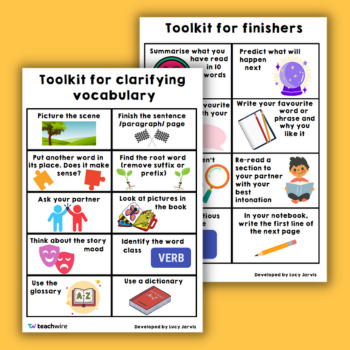How to teach reading – We improved progress with this lesson structure

Dump the boring books and reenergise poetry and prose with this simple lesson structure

- by Lucy Jarvis

Is there a lack of love for reading in your school? Are your children struggling with their fluency? Are you stuck in a cycle of unambitious and boring books that you don’t ever refresh? Wondering how to teach reading with some pizazz?
If you answered yes to any of these questions, then it might be time to shake things up and reenergise your reading lessons.
Reading lists
Before the start of the new academic year, you might want to consider the exposure your children have to different text types.
At my school, we restructured our reading curriculum so that Y2–6 began each term with a non-fiction text (linked to their topic), followed by a fiction text and finally ending with either a picturebook, video, graphic novel or play script.
This range wasn’t in our curriculum before, and our children were mainly limited to fiction.
But children need to see a range of text types, as if they don’t, they will never be given the chance to explore other reading that isn’t just standard stories.
Reading lesson ideas
We have five reading lessons in our school: four structured ones and one library session, which is where the children read for pleasure.
The other four reading lessons are 45 minutes long for KS2 and 30 minutes for Y2. Our reading lessons follow this structure:
Vocabulary pre-teach (5 mins)
In this warmup, key vocab is pulled from the text the children will be reading in the lesson.
We use pictures alongside trickier words, and add vocabulary to our reading working walls with definitions.
Low-stakes recap quiz (5 mins)
This is five minutes spent quizzing the children about what they read yesterday and the week before.
Often done verbally, but can be done on whiteboards or using Kahoot/Padlet.
Pupils discuss what has happened in the text so far (fiction) or what they learned from the text previously (non-fiction). As a class, we discuss and ensure that we are all on the same page.
Teaching the children how to read (10 mins)
I was inspired by Pie Corbett’s Talk 4 Reading book where he discusses why you shouldn’t focus on just one skill during a reading lesson – the children need to learn to read as a whole.
As a result, we don’t focus on a skill (inference, for example). We begin with an exploratory question such as ‘How does Michelle Paver build tension in chapter four?’
Then we may use inference, prediction, summarising skills, etc to become strong readers.
During this ten-minute slot, the teacher models intonation and reading to the children; how to clarify unknown words; and how to answer questions about the text.
Whatever the teacher models here is what pupils are expected to do in the next part of the lesson.
Children reading aloud with their partners (20 mins)
The biggest mindset change for our teachers was that our children don’t read in their head for their lessons anymore.
Instead, they’re sat in mixed-ability pairs and will read out loud (taking it in turns to read a section at a time) to each other.
They must be mixed ability, but if you have a child working two or more years below the rest of the class, then you may need to look at adding some pre-teach in and ensure their partner takes the lead.
While pupils are reading aloud, they are working on their clarifying skills – we use a prompt on the tables that gives them different ways to clarify unknown vocabulary, which we model first.
If pupils finish early, we have another prompt (a ‘toolkit for finishers’ – which gives them little tasks to complete. Download both worksheets at tinyurl.com/tp-VocabToolkits or from the resource panel at the top of this article.
Children answer questions (5 mins)
At the end of the paired reading, children answer one or more questions about what they’ve read.
This is linked to the initial question introduced at the start of the lesson, and can be recorded in their books or just be a verbal discussion.
Mini quizzes
Once every two weeks (or once every week in Y6) the children take a mini quiz.
They will read the text alone this time and answer multiple questions about it. You can track mini quiz results and give support to children who struggle.
This builds independence and prepares pupils for future reading assessments.
Reading speed
Speed of reading seems to be only something that people check at the end of KS2, but we track it from the end of Y2.
This is because we understand that reading speed is a huge barrier for some children, and is also often missed and not considered when wondering why a child hasn’t made progress.
So, from the end of Y2, our TAs test the children’s reading speed six times a year.
From this data, they are able to identify who is partnered with who in reading lessons, who needs fluency interventions, and who needs extra 1:1 reading.
Reading progress
After eight months of trialling this structure, we have seen very positive impact.
For example, percentages of pupils on track have increased in every year group; we’ve seen increases of 41 per cent in Y3, and 24 per cent in Y6.
Alongside this, progress across school is good and the gap is closing between those who are not meeting the expected standard and those who are.
However not all progress can be measured by data. Children who used to get frustrated reading snippets of texts, now see a book through to the end and speak extremely positively about the experience.
Pupils’ vocabulary is improving rapidly and the link we make between reading and writing is showing.
Poet and author visits are extremely important to our school, and we aim to have a visitor each term. As a result, children are inspired to write poetry and we have had many children enter poetry competitions and get published!
How to prepare lessons
So, how can you prepare for September? Firstly, look at your reading offer – are children getting a variety? Are you exposing pupils to high-quality and ambitious texts for their age range?
Remember, the fiction book does not have to link to the topic you’re reading: try not to force links that aren’t there.
High quality has to come first and there are so many incredible texts out there.
Secondly, reconsider your reading lesson structure.
How often do children read out loud to each other? Are you still grouping by ability? If you are, that must change.
Stop putting ceilings on children and expose them to books that challenge them (with support if needed).
Lastly, have more fun with reading. Competitions, poet and author visits (even virtual ones are hugely impactful), reading newsletters, teacher reading swaps, reading buddies etc – is reading prominent in your school?
Would I walk into your school and think ‘this school prioritises reading?’ If not, why not?
Remember that reading is the key to everything you do in school! If your children can’t read, then they can’t access anything else in the curriculum.
Our reading lesson structure
- 5 minutes – vocabulary pre-teach.
- 5 minutes – low-stakes recap quiz.
- 10 minutes – teaching the children how to read.
- 20 minutes – children reading aloud with their partners.
- 5 minutes – children responding to questions about the text.
Lucy Jarvis is an assistant headteacher, Y6 teacher and English lead at a primary school in Lincolnshire.







